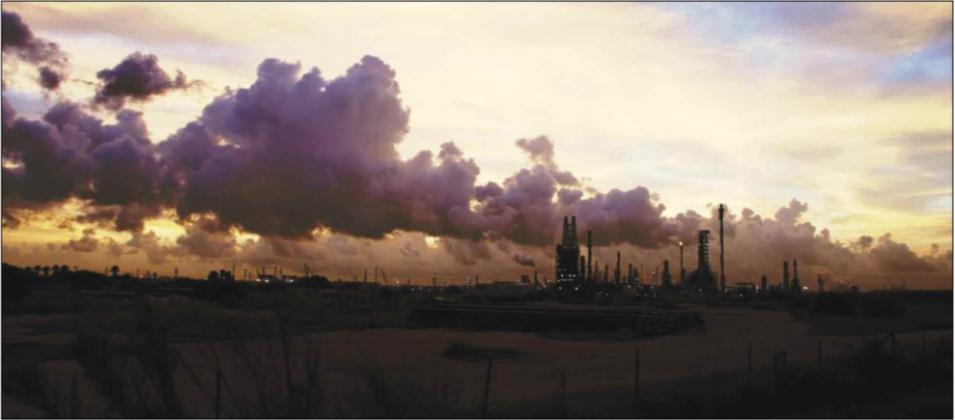Discovering the pollution plume
Even as McMillan and his team provided daily satellite data to guide aircraft flights within the state, remote sensing also permitted the investigators to view larger drift patterns. Estes said, “A satellite can observe large-scale movements of air much better than one or two airplanes or a bunch of ground stations can. Satellite data can often reveal a causal link if you can track the pollutant plume from its origin all the way to the city of interest, kind of a source receptor relationship.” During the field study, air quality experts discovered where some of Houston’s pollution was coming from.
Scientists had already used satellite data to track air pollution from China wafting to North America, and had followed smoke from Brazilian forest fires streaming across the tropics. But AIRS data revealed that the pollution drifting into Houston came from less exotic sources. McMillan said, “One of the biggest impacts that we saw was actually smoke from extensive forest fires in Montana and Idaho. During late August, air pollution from the fires was transported right down across the Great Plains into Texas.” The wildfire smoke, generated between August 26 and 30, drifted 2,090 kilometers (1,300 miles) before blowing into Houston in early September. At the same time, air pollution from the Midwest also drifted into southeastern Texas. Consequently, on September 1, ozone levels in Houston reached 129 ppb. “It was one of the worst ozone events in Houston during the summer of 2006,” McMillan said. “Houston’s poor air wasn’t caused by the drifting pollution, but it was influenced by it.”
Observing how and when pollution was transported into the state helped air quality experts understand the role drifting pollution played in compounding Houston’s already poor air quality. During certain summer days, when Houston’s ambient ozone levels were already high, enough pollution drifted in to produce unacceptable ozone levels. The study helped define an additional challenge for the state: because cities in Texas have no control over pollution generated elsewhere, they must make up for that by more strictly regulating what they can control—their own emissions.
Mitigating the drift
Estes and other air quality officials rely on data from studies like TexAQS II to formulate state air quality programs. They enter the findings into computer-modeled emission scenarios, extrapolate current emissions into the future, and estimate where the state could reduce emissions. For instance, what if industrial plants emitted fewer pollutants, or what if vehicles passed tighter emissions standards? Estes said, “You can run different scenarios and discover the consequences of various emission reductions.” The state then negotiates with local governments and industries to decrease emissions. The resulting package of reductions, explaining how the state will mitigate air quality problems, goes to the EPA.
The field portion of the TexAQS II study confirmed that pollutants from one source might affect a community thousands of miles away. The study also proved that effectively tracking long-distance pollution drift requires broader coverage, so cities like Houston are beginning to incorporate remote sensing into their air quality management. Estes said, “To get data over large areas, you often have to rely on satellite data. If you have good satellite data, you can fill in the blanks between your monitoring stations.” It is an ongoing challenge, but every new source of information supplies experts with one more way to refine pollution models and negotiate emission reductions.
References
McMillan, W. W., C. Barnet, L. Strow, M. T. Chahine, M. L. McCourt, J. X. Warner, P. C. Novelli, S. Korontzi, E. S. Maddy, and S. Datta. 2005. Daily global maps of carbon monoxide from NASA’s Atmospheric Infrared Sounder. Geophysical Research Letters 32, L11801, doi:10.1029/2004GL021821.
Texas Commission on Environmental Quality. Final rapid science synthesis report: Findings from the Second Texas Air Quality Study (TexAQS II) . https://www.tceq.texas.gov/assets/public/implementation/air/am/texaqs/rsst_final_report.pdf
For more information
NASA Goddard Earth Sciences Data and Information Services Center (GES DISC)
Atmospheric Infrared Sounder (AIRS)
Texas Air Quality Field Study II (TexAQS II)
Texas Commission on Environmental Quality (TCEQ)
| About the remote sensing data |
| Satellite |
Aqua |
| Sensor |
Atmospheric Infrared Sounder (AIRS) |
| Data set |
Level 1B AIRS Infrared Geolocated Radiances |
| Resolution |
13.5 kilometer |
| Parameter |
Carbon monoxide |
| DAAC |
NASA Goddard Earth Sciences Data and Information Services Center (GES DISC) |


